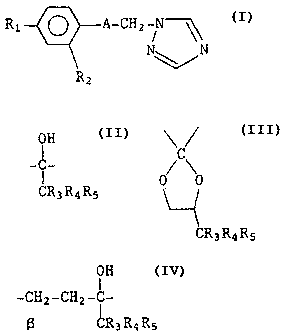Une partie des informations de ce site Web a été fournie par des sources externes. Le gouvernement du Canada n'assume aucune responsabilité concernant la précision, l'actualité ou la fiabilité des informations fournies par les sources externes. Les utilisateurs qui désirent employer cette information devraient consulter directement la source des informations. Le contenu fourni par les sources externes n'est pas assujetti aux exigences sur les langues officielles, la protection des renseignements personnels et l'accessibilité.
L'apparition de différences dans le texte et l'image des Revendications et de l'Abrégé dépend du moment auquel le document est publié. Les textes des Revendications et de l'Abrégé sont affichés :
| (12) Brevet: | (11) CA 2088692 |
|---|---|
| (54) Titre français: | COMPOSITIONS FONGICIDES |
| (54) Titre anglais: | FUNGICIDAL COMPOSITIONS |
| Statut: | Durée expirée - au-delà du délai suivant l'octroi |
| (51) Classification internationale des brevets (CIB): |
|
|---|---|
| (72) Inventeurs : |
|
| (73) Titulaires : |
|
| (71) Demandeurs : |
|
| (74) Agent: | KIRBY EADES GALE BAKER |
| (74) Co-agent: | |
| (45) Délivré: | 2005-01-18 |
| (22) Date de dépôt: | 1993-02-03 |
| (41) Mise à la disponibilité du public: | 1993-08-06 |
| Requête d'examen: | 2000-02-03 |
| Licence disponible: | S.O. |
| Cédé au domaine public: | S.O. |
| (25) Langue des documents déposés: | Anglais |
| Traité de coopération en matière de brevets (PCT): | Non |
|---|
| (30) Données de priorité de la demande: | ||||||
|---|---|---|---|---|---|---|
|
Wood preserving composition comprising a compound of formula I
(see formula I)
wherein
A is selected from (i) (see formula II and formula III)
and (see formula IV)
whereby the .beta.-carbon attaches to benzene ring of formula (I);
R1 and R2 are independently H or Cl;
R3 and R4 are independently H or CH3; and
R5 is methyl, ethyl or cyclopropyl
and method for preserving wood with the aid of a compound of
formula (I).
Note : Les revendications sont présentées dans la langue officielle dans laquelle elles ont été soumises.
Note : Les descriptions sont présentées dans la langue officielle dans laquelle elles ont été soumises.

2024-08-01 : Dans le cadre de la transition vers les Brevets de nouvelle génération (BNG), la base de données sur les brevets canadiens (BDBC) contient désormais un Historique d'événement plus détaillé, qui reproduit le Journal des événements de notre nouvelle solution interne.
Veuillez noter que les événements débutant par « Inactive : » se réfèrent à des événements qui ne sont plus utilisés dans notre nouvelle solution interne.
Pour une meilleure compréhension de l'état de la demande ou brevet qui figure sur cette page, la rubrique Mise en garde , et les descriptions de Brevet , Historique d'événement , Taxes périodiques et Historique des paiements devraient être consultées.
| Description | Date |
|---|---|
| Inactive : Périmé (brevet - nouvelle loi) | 2013-02-03 |
| Inactive : CIB de MCD | 2006-03-11 |
| Inactive : Lettre officielle | 2005-04-18 |
| Inactive : Renversement de l'état sera réputé périmé | 2005-04-18 |
| Inactive : Lettre officielle | 2005-02-28 |
| Inactive : Lettre officielle | 2005-02-23 |
| Lettre envoyée | 2005-02-03 |
| Accordé par délivrance | 2005-01-18 |
| Inactive : Page couverture publiée | 2005-01-17 |
| Préoctroi | 2004-11-02 |
| Inactive : Taxe finale reçue | 2004-11-02 |
| Un avis d'acceptation est envoyé | 2004-05-13 |
| Un avis d'acceptation est envoyé | 2004-05-13 |
| Lettre envoyée | 2004-05-13 |
| Inactive : Approuvée aux fins d'acceptation (AFA) | 2004-05-04 |
| Modification reçue - modification volontaire | 2004-04-08 |
| Inactive : Dem. de l'examinateur par.30(2) Règles | 2003-10-08 |
| Lettre envoyée | 2002-11-13 |
| Inactive : Transferts multiples | 2002-09-30 |
| Inactive : Renseign. sur l'état - Complets dès date d'ent. journ. | 2000-02-29 |
| Lettre envoyée | 2000-02-29 |
| Inactive : Dem. traitée sur TS dès date d'ent. journal | 2000-02-29 |
| Exigences pour une requête d'examen - jugée conforme | 2000-02-03 |
| Toutes les exigences pour l'examen - jugée conforme | 2000-02-03 |
| Lettre envoyée | 1998-03-04 |
| Lettre envoyée | 1997-10-15 |
| Inactive : Transferts multiples | 1997-09-19 |
| Demande publiée (accessible au public) | 1993-08-06 |
Il n'y a pas d'historique d'abandonnement
Le dernier paiement a été reçu le 2003-12-23
Avis : Si le paiement en totalité n'a pas été reçu au plus tard à la date indiquée, une taxe supplémentaire peut être imposée, soit une des taxes suivantes :
Veuillez vous référer à la page web des taxes sur les brevets de l'OPIC pour voir tous les montants actuels des taxes.
Les titulaires actuels et antérieures au dossier sont affichés en ordre alphabétique.
| Titulaires actuels au dossier |
|---|
| SYNGENTA PARTICIPATIONS AG |
| MARK D. MCDADE |
| Titulaires antérieures au dossier |
|---|
| S.O. |